|
|
|
|
|
|
|
Goodell-Pratt Company - Greenfield, MA
|
|
|
|
|
|
|
|
|
Goodell Brothers - the
Bedrock of Goodell-Pratt Co.
by Wiktor Kuc |
 6 of 19
6 of 19
 |
|
|
Some of the solutions in this screwdriver
are very simple and still sound. I am specifically impressed with the simplicity
and reliability of the chuck.
The idea here is straight forward - the jaws of
the chuck are not designed to exert pressure on the bit's shank
to keep it from turning. They simply guide a shank "into the said annular groove of said spindle" and
then just keep it in that place.
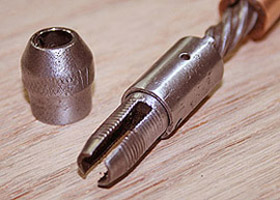 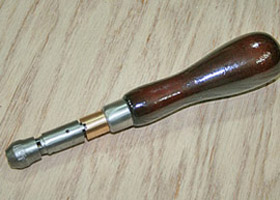
This of course meant a proprietary shape of the screw driver
shank, but the construction is so simple, it's impressive.
Even before the
patent was officially awarded, the demand for Goodells
screwdrivers and other products was so great that they had to
hire additional employees. By 1890 they reported employment of 3
new male employees, between 14 and 16 years old.(9)
Together with two brothers, it was small, 5 men shop operation.
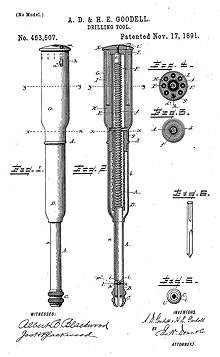 Other patents followed shortly after.
In September, 1890 they filed an application for two patents and
were awarded on November 17, 1891 patent
No. 463,506 for
the Automatic Screw Driver and
patent
No. 463,507 for
the Drilling-Tool. Other patents followed shortly after.
In September, 1890 they filed an application for two patents and
were awarded on November 17, 1891 patent
No. 463,506 for
the Automatic Screw Driver and
patent
No. 463,507 for
the Drilling-Tool.
The Drilling-Tool patent introduced for the
first time the bit storage, never seen before. The Goodells
described their invention in the following description:
"Our present invention relates to certain
improvements in tools for drilling holes in wood and other
materials of like nature by the exertion of pressure
repeatedly upon the handle of the same to automatically
revolve the bit. The invention, however, has to do more
particularly with the portion of the tool which forms the
holder for the drill-bits not in use, and this in
combination with the operating portion of the tool."
In this patent the Goodell devised a four-jaw chuck
and introduced a unique
shape of the shank for their bits - a cross shaped cross-section
adopted to their four-jaws chuck. This shape became a
characteristic feature of the Goodells' push-drills.
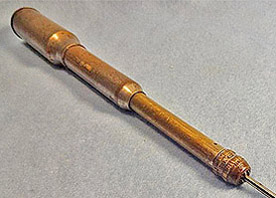
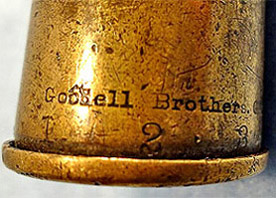
Another, lesser known patent receive by the Goodells
on April 5, 1892 is patent
No. 472,259 for Shoe Float or Rasp. Here is a
partial patent text
describing this tool:
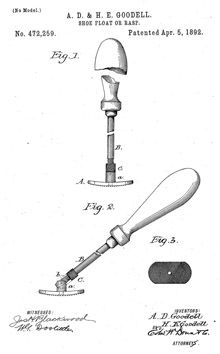
“Our present invention relates to an
improvement in what is known as ‘shoe-floats’ for removing
pegs and nails from the insole of shoes; and our object is
to provide a tool suitable and convenient more particularly
for home use, useful, and economical.
It consists, essentially, of a plate of
steel (treated on one surface in a manner somewhat like that
of a file or rasp) and having points turned in one direction
hinged to a handle and rendered adjustable to any required
handle by means of screw-threaded collar which works over a
screw-threaded projection or boss on said plate, to which
said handle is hinged."
Even though the tool targeted the home market,
it is worth noting that the shoe-making industry in Massachusetts
was flourishing since the early 19th century and potential
market for this tool was wide. These patents drove the production of new tools at Goodell Brothers.
Sale of tools was handled by H. H. Mayhew & Co., an outlet
producing small hand tools in Shelburne
Falls. The connection to this company played a very
important role in the future developments.
Despite the appearance of a well working team,
some glitches put the brothers' venture in jeopardy. In 1892 Albert D. decided to part with Goodell Brothers. He sold
his interest in the company to Henry E. and moved to
Worcester, MA, to start his own venture. We don’t have any
source material that would explain this event. Actually,
all sources I have examined are peculiarly quiet and don't offer any explanation.
We can only assume that this was a difficult time for Henry E.
After working together with his brother since the Buckland days, he
now faced sole responsibility for the business they started together.
Albert D. most likely experienced similar fears. After all, he
also invested a good chunk of time and work in building the
business that now he decided to abandon. The future was most
likely uncertain for him as well.
After Albert's departure, Henry E. decided to
continue business as the Goodell Brothers but not in
Shelburne Falls. He devised a plan to move the company to Greenfield. By September, 1892,
he chose the location for the new factory and construction
began. The plan was to build a two story brick building, with dimensions of 72 by 32 feet, with
a boiler house, 31 x 23 feet, and a chimney 50 feet high.(10)
Shortly after, Dexter Wood
Goodell appeared on the scene.(11) He was the oldest brother
of the three. Just like his brothers, Dexter was
an experienced patternmaker, mechanic, and inventor.
The Greenfield Recorder, October 30, 1901 described Dexter W. as follows:
"Mr. Goodell was born in Whitingham, Vt.,
and was one of a family of 12 children of Anson Goodell.
Later the family moved to Readsboro, VT. At the age of
sixteen Mr. Goodell went out into the world to seek for
himself. Mr. Goodell finally settled in Florence
and married Miss Cassie Pomeroy of that town. He had a
prominent position with the Florence Sewing Machine company
and worked for this concern for over thirty years. He was
one of the pioneers in the manufacture of the Florence oil
stove made by this company.
In 1892 Mr. Goodell came to Greenfield and
in company with his brother Henry E. Goodell, who moved to
Greenfield from Shelburne Falls, started the manufacture of
mechanics' tools of all kinds under the name of Goodell
Brothers.
Mr. Goodell sold out his interests in the
business to his brother several years ago and went into the
manufacturing of nail pullers and other things in
Springfield, but retained his residence here."
(9)
Springfield Republican, March 17, 1890,
(Springfield, MA), 6; Report of the Chief Massachusetts
District Police for The Year Ending December 31, 1889,
Inspection And Detective Departments of Massachusetts District
Police. (Boston, MA), 422-423.
(10)
Biographical Review Publishing Company, Biographical Review - Biographical Sketches of the Leading
Citizens of Franklin County, Massachusetts, (Boston, MA,
1895), 326;
Bureau of Statistics of Labor,
Commonwealth of Massachusetts, The Annual Statistics of
Manufactures for 1892, (Boston, MA: 1893), 450; Cope, Kenneth, Sorting
out the Goodell Companies, Chronicle of the Early American
Industries Association, v. 45, no. 4, (Levittown, NY,
1992), 115.
(11) Greenfield Recorder, October 30, 1901.
Jenkins, Paul, The Conservative Rebel, A social History of
Greenfield, Massachusetts, (Town of Greenfield,
Massachusetts, 1982), 172; Various other sources imply
that it was Dexter W. who started company in Greenfield.
Others suggest that Dexter moved to Shelburne Falls first and
then, together with Henry E., relocated the business to
Greenfield.
|
|
|
|
|
 6 of 19
6 of 19
 |
|
|
|